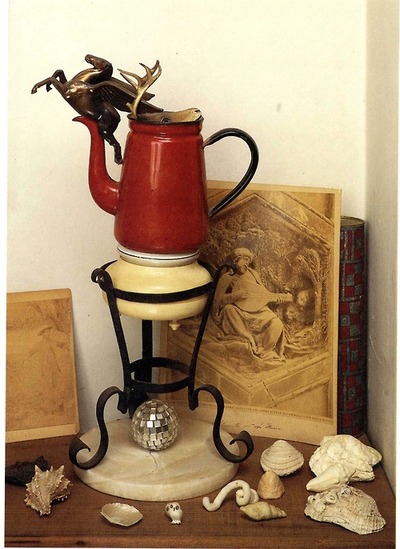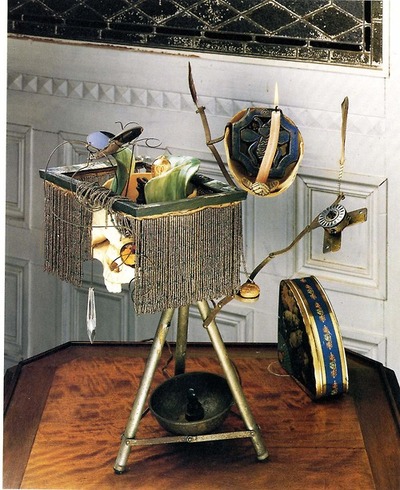The Assemblages of Jess
 Poet's Coffeepot (1963). © 2010 The Jess Collins Trust. Reproduced by Permission. Collection of Robert Glück, San Francisco.
Poet's Coffeepot (1963). © 2010 The Jess Collins Trust. Reproduced by Permission. Collection of Robert Glück, San Francisco.Jess Collins, San Francisco artist and partner to poet Robert Duncan for 37 years, was a collector. He was also a recluse. British painter R.B. Kitaj, one of Jess’s contemporaries, noted: “He hardly goes outside. He leaves that to Robert Duncan who goes outside a lot.” When Jess—as he was and is known—did leave the house, it was to go rummaging through thrift stores looking for castoff gems, doodads, and thingamabobs: an antique teacup, a wizened clay Santa, broken old tools, crystals, mini disco balls, hinges, feathers, a jar of marbles affixed with a sticker reading “boneless.” Collins arranged these things into small-stage sets, adjusting, balancing, and tinkering until each object stood both alone and adjacent (though never affixed) to other objects.
Take Poet’s Coffeepot from 1963, for instance: A red tin coffeepot sits balanced on a wrought-iron curlicued plant stand, the head of a deer poking out from the coffeepot. Balanced in its antlers is a bronze Pegasus almost floating in the air. Below the coffeepot is a single mirrored ball. Behind the pot, an old print of a man playing the guitar. Seashells surround the pot. In the very center, a small toy owl.
These everyday household items, playthings, and uncanny found objects create meaning through their arrangement. The choices Jess made to place an item here or there imply associations. In each work the objects, once placed in proximity to another thing, suggests something poetic.
“I’ve, at times,” Jess said, “found wonderful things on the street, just thrown away. If you find something that you really respond to that someone else has thrown away, it’s a kind of mini-salvation.”
It is romance, salvation, that turns a throwaway object into a thing called art, the process of hoarding away items in a home, and the forming of attachments to objects that are not unlike attachments to people. Or the turning of Nature, the whole world itself, into a type of assemblage.
Burgess Collins, born in 1923 in Long Beach, California, was a radio chemist in 1948 when he had a lucid dream about the world ending. He woke up from the dream and changed his name to Jess. In an interview, the animator Larry Jordan said of Jess: “He said it’s in the hands of black magicians, pooh. And would have nothing more to do with science and went into painting.” So Jess went to art school. In art school he painted thick landscapes of impastoed paint. After art school he started making elaborate collages that he called “Paste-Ups.” In 1949 he went to a reading in Berkeley and fell in love when Robert Duncan read “The Venice Poem.”
Alone, I know not where I am.
The world is false as water.
It echoes back the heart’s desire.
Love burns in changes of the moon.
The picture of Poet’s Coffeepot that I’m looking at was taken in Jess and Robert Duncan’s living room. These works, first called “Necrofacts” (dead objects) and then later Assemblies, were exhibited at the Museum of Modern Art’s Assemblage show in 1961. William Seitz, the curator of the exhibition, described Assemblage nicely: “It is metaphysical and poetic as well as physical and realistic.” Metaphysical, poetic, physical, realistic. After the exhibition, Jess decided the works were too fragile to exhibit again. He cared for the Assemblies (enough, in fact, to rename them) and placed them throughout the home that he and Duncan shared. The Assemblies were objects to live with. To hole up with. To recluse with. Objects to arrange endlessly.
Guillaume Apollinaire said there is freedom in assembling a poem out of disparate parts. Of the Cubists, he said, “You may paint with whatever material you please, with pipes, postage stamps, postcards or playing cards, candelabra, pieces of oil cloth, collars, painted paper, newspapers.”
Maybe we could call the Assemblies “recluse art.” Very little has been written about them, and I’ve found only one book that features photos of the work. The book title’s parenthetical implies their lesser importance: Jess: Paste-Ups (and Assemblies) 1951–1983.
In the 1950s abstract expressionism, gestures of paint and abstraction, was the thing. It was Jess’s thing too for a while. He studied with Clyfford Still at the California School of Fine Arts, later to be renamed the San Francisco Art Institute. At times, it seems the Assemblies resist the lofty notions of the abstractionists: the sublime, the awe of nature. Instead, they are small individual gestures, almost tabletop sculptures. What I’m saying is that not one of the objects transcends its objectness, its thingness.
In their very thingness, though, the Assemblies are almost like abstract painting of the 1950s. The objects placed carefully together create a sense of an everyday magic and myth, a sort of romanticism of the thing.
In a letter to Jess and Duncan dated June 1962, artist Stan Brackage wrote: “You are such incredible magicians; and when you are together, the spell is of such majestic beauty to me as to be ‘indescribable.’”
Magic can be assigned to any number of things—a skull, a crystal, a burning candle. All of these items exist in Assembly Lamp #5 (1961), which is something resembling a vanitas—a form of still life that was developed in 17th-century northern Europe and features objects, such as books, mirrors, skulls, and candles, that symbolize the fleeting nature of time, earthly life, and the transience of beauty and youth. Jess plays with the trope of the vanitas by placing a living thing, a plant, in the center. Feathers are affixed to protruding wires, a blue decorative box sits to one side, a medicinal bowl is in the center. A curtain of beads half-cover the skull. The objects are not affixed to one another in any permanent way.
 Assembly Lamp #5 (1961). © 2010 The Jess Collins Trust. Reproduced by Permission.
Assembly Lamp #5 (1961). © 2010 The Jess Collins Trust. Reproduced by Permission.Jess wrote: “They are balanced, intertwined, jammd, lockd, screwd, hung, loopd, linkd, tied; rarely cemented or taped.” Each of the items is provisionally attached to one another. Nothing is permanent, there are no dead objects, just the perpetual potential for rearrangement.
It is not just the arrangement of the objects that suggests a kind of magic, but the attachment to objects too. The intimacy between things. Jess understood that any old object could be imbued with potency—including tarot cards, crystals, the marks of the I-Ching throw, all of those Catholic things.
Enjambment can be spiritual too. Or at least it can suggest a new way of seeing old things. Rather than a still life from the 17th century, the Assemblies might be understood as three-dimensional collages—each object bestriding another object. Robert Duncan’s poems have been called collages too. Poet Michael Davidson described Duncan’s poems as “a compositional field where anything might enter: a prose quotation, a catalogue, a recipe, a dramatic monologue, a diatribe.”
Jess was prolific. Not only did he create Assemblies but he also continued to paint and create Paste-Ups until he died in January 2004. He illustrated books for Denise Levertov, Jack Spicer, and, of course, Robert Duncan. Usually they were loose, sketchy decorations—the names of the poets were viney branches, or titles were dotted with animals and flowers. You can imagine Jess in his studio in the home he and Duncan shared, the home he rarely left, carefully drawing these out for his friends. Of course, a book is an object, too.
When asked, “What kind of artist is Jess?” Jess responded: “The most I can think of is romantic. I’ve always thought of myself as romantic.”
When asked if he sees painting as a spiritual process, Jess responded: “Yes, I certainly do. However, I don’t see that much difference between the spiritual and the material. All matter is energy, and all matter and energy are infused with spirit.”
One more Assembly. This one is simple. Hiawatha (1962) features the top half of a dime-store Indian looking seriously off into the distance. A plastic horse head, mid-neigh, is affixed to the head of the Indian like a jaunty hat.
Katie Geha is a writer, curator, and art historian. She is director and chief curator of the galleries in the Lamar Dodd School of Art and its downtown outpost, The Athenaeum.
-
Related Authors
- See All Related Content

THis is wonderful. I am inspired. The collages and assemblies remind me of the recent work of Austin TX artist Marjorie Moore.